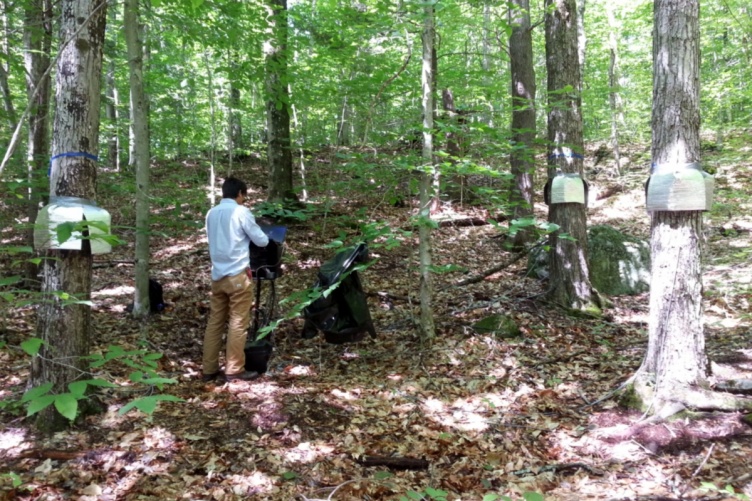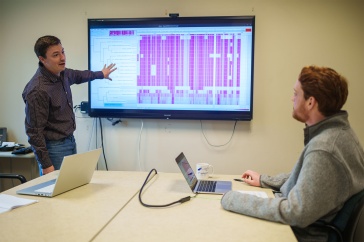
These trees are instrumented with sap flow sensors that measure how much water the trees are using day during the growing season. The data are being downloaded to a computer by doctoral student Jose Gutierrez. Credit: Heidi Asbjornsen/UNH
Preliminary research results from the University of New Hampshire show that certain tree species in New Hampshire fared better at the height of the 2016 New England drought and were able to continue taking up water even when soils were very dry.
The research was conducted by NH Agricultural Experiment Station researcher Heidi Asbjornsen, associate professor of ecosystem ecology. “Climate change forecasts predict that the northeastern United States will see both an increase in total annual rainfall and a higher frequency of prolonged dry spells. The severe drought that affected much of New England during the summer of 2016 served as first glimpse of what such a future climate may look like,” Asbjornsen said.
Asbjornsen will discuss the preliminary results of her research project at the NH Agricultural Experiment Station education session “Thirsty Trees: How the 2016 Drought Impacted New Hampshire’s Forests” at the 2017 NH Farm and Forest Exposition. The exposition will be held Feb. 17 and 18 in Manchester. The experiment station’s education sessions “Beetle Bandits, Bats, and Bees” take place from 1 to 3:30 p.m. Friday in the Stark Room of the Radisson Hotel, 700 Elm Street, Manchester.

Asbjornsen and her team are trying to understand the impacts of drought on New Hampshire’s forests, and the potential impacts on providing important ecosystem services to the state’s communities such as water resources; the production of timber, maple syrup, and other forest products; flood mitigation; and recreational opportunities.
According to the NH Division of Forests and Lands, New Hampshire is nearly 84 percent forested, and the forest’s direct impact on the economy of the state is $2.26 billion annually. This research is particularly important to foresters, land managers, and landowners.
UNH scientists conducted research at three different sites in New Hampshire: the UNH Thompson Farm in Durham, the UNH Organic Dairy Research Farm in Lee, and the Hubbard Brook Experimental Forest in the White Mountains. Both Thompson Farm and the Organic Dairy Research Farm are experiment station facilities.
They found that during the height of the drought in late August and early September, white pine, hemlock, and red oak trees experienced severe moisture stress, as indicated by the almost complete cessation of water uptake for a period of several days. However, red oak exhibited greater drought tolerance, as indicated by its ability to continue photosynthesizing even when soils were very dry.
“We also observed that the forests in southern New Hampshire were more strongly affected by the 2016 summer drought than the forests in the White Mountains,” Asbjornsen said.
In addition to presenting details of the preliminary research results at the experiment station education session, Asbjornsen will discuss the implications of these findings for sustainably managing New Hampshire’s forests for diverse ecosystem services in the face of future climate change.
This material is based upon work supported by the NH Agricultural Experiment Station, through joint funding of the National Institute of Food and Agriculture, U.S. Department of Agriculture, under award number 1003450, and the state of New Hampshire. For more information on this project, visit http://www.ecohydro.sr.unh.edu/.
Founded in 1887, the NH Agricultural Experiment Station at the UNH College of Life Sciences and Agriculture is UNH’s original research center and an elemental component of New Hampshire's land-grant university heritage and mission. We steward federal and state funding, including support from the USDA National Institute of Food and Agriculture, to provide unbiased and objective research concerning diverse aspects of sustainable agriculture and foods, aquaculture, forest management, and related wildlife, natural resources and rural community topics. We maintain the Woodman and Kingman agronomy and horticultural research farms, the Macfarlane Research Greenhouses, the Fairchild Dairy Teaching and Research Center, and the Organic Dairy Research Farm. Additional properties also provide forage, forests and woodlands in direct support to research, teaching, and outreach.
-
Written By:
Lori Tyler Gula, PhD | NH Agricultural Experiment Station | lori.gula@unh.edu | 603-862-1452

















































